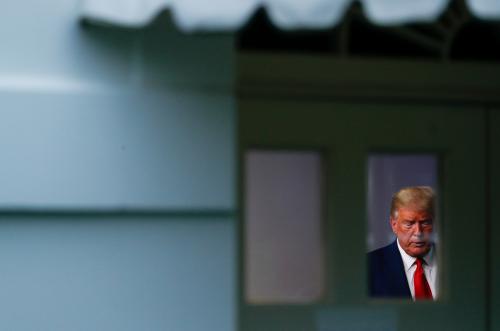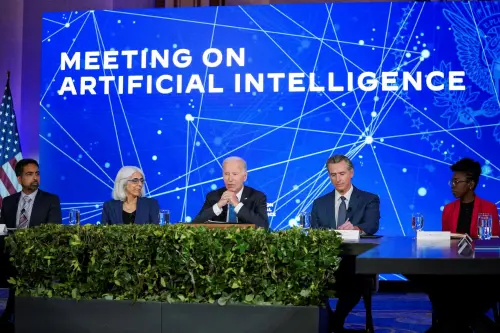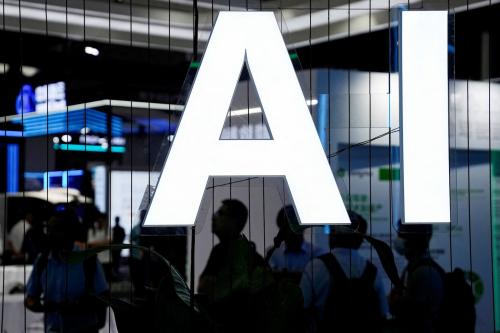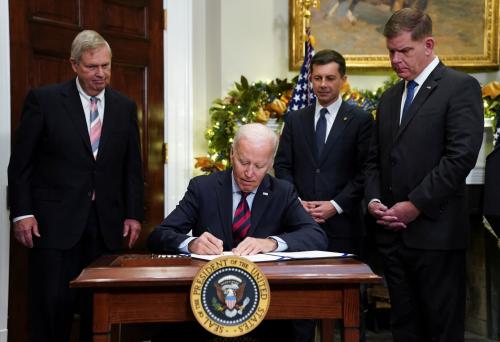This report is part of the Series on Regulatory Process and Perspective and was produced by the Brookings Center on Regulation and Markets.
Federal government Inspectors General (IGs), who are charged with preventing and identifying “waste, fraud, and abuse” in their agencies, generally labor in obscurity. Sometimes, their investigations do take center stage. In late July, for example, after clashes between demonstrators and federal law enforcement agents in Portland, Oregon, IGs of the Departments of Homeland Security and Justice initiated probes into their agencies’ use of force.
But lately the IGs themselves have made regular appearances in the Friday night news. In early April, President Trump fired Michael Atkinson, the intelligence community’s IG who had dealt with the Ukraine whistleblower complaint that featured prominently in the President’s impeachment. A few days later, the President removed Glenn Fine, who had been doing the job of the Defense Department IG, thereby preventing him from serving as the chairman of the Pandemic Response Accountability Committee. Fine’s IG peers had selected him to oversee more than $2 trillion in government stimulus spending.
More removals followed in May. At the start of the month, President Trump claimed that he was getting rid of Christi Grimm, the temporary IG at the Department of Health and Human Services, after she reported “severe shortages” in hospital supplies during the pandemic. (She remains, however, as principal deputy IG, carrying out the vacant job’s duties). The President next fired Steve Linick, the IG for the State Department. He also replaced the career acting IG for the Department of Transportation, Mitch Behm, with a new interim political official, Howard “Skip” Elliott.
In response to these staffing purges, Democrats and Republicans in Congress have proposed legislative reforms ranging from limitations on IG removal to restrictions on who can serve as an acting IG. One proposal on acting IGs recently made it into the House’s version of the National Defense Authorization Act for Fiscal Year 2021, which the White House has threatened to veto.
IGs form a crucial accountability mechanism in our contemporary federal bureaucracy. Legislators established these Senate-confirmed watchdogs in cabinet departments and major agencies during the Carter Administration, and both parties have feted modern IGs, who have reporting obligations to agency heads as well as to Congress. While IGs are most known for ferreting out “waste, fraud, and abuse” in regulatory agencies, they also conduct evaluations of key agency programs to improve their effectiveness. If they are systematically undermined by a hostile President, the quality of our governance is likely to suffer. The stakes for reform are, therefore, high.
But would-be reformers’ good intentions do not guarantee that their proposed changes will have good effects. To assess these proposed reforms and some of their unintended consequences, one must primarily consider the empirical realities of staffing vacancies in IG positions and the role of acting officials and delegations of authority. The Supreme Court’s recent decision about the constitutionality of the Consumer Financial Protection Bureau plays a small part as well.
Staffing Shortages
IG positions have always suffered from vacancies. The problem has been especially bad in recent Administrations. The amended Inspector General Act of 1978 and other statutes created 36 IG jobs that require presidential nomination and Senate confirmation.[1] In addition, the President must select a nominee “without regard to political affiliation” and “on the basis of integrity and demonstrated ability in accounting, auditing, financial analysis, law, management analysis, public administration, or investigation.” Senate-confirmed positions come with delays at both the nomination and confirmation stages.
IGs don’t fare well in the appointments process, with above-average failure rates and confirmation delays compared to other agency roles. Between 1981 and 2016, more than one-quarter of IG nominations were withdrawn or, more frequently, returned by the Senate. In President Obama’s last year, Senate Republicans blocked all twelve of his IG nominees. Nominations that were confirmed in the 1981-2016 period took, on average, 104 days. These figures consider each nomination separately: if it takes two nominations (often of the same person) to get a confirmed IG, two years can easily go by. Vacancies, including delays in nominations, are also longer for IGs.
The Council of the Inspectors General on Integrity and Efficiency, among others, tracks IG vacancies online. At the high end, as of the end of July, the Export-Import Bank has lacked a confirmed IG for over six years and the Central Intelligence Agency for five and a half years. Seven of the fifteen cabinet departments currently do not have a confirmed IG.
Alternatives to Confirmed IGs
Titles can get confusing when there are not confirmed IGs in place. The Federal Vacancies Reform Act of 1998 permits acting IGs in some circumstances. But agency delegation orders typically allow principal deputy IGs to carry out the IG’s functions when the Act’s time limits run out. These technical complexities matter for accountability.
Take Glenn Fine at the Defense Department. When the White House demoted him from leading the IG office, many commentators called him the acting IG. But he wasn’t. After the last confirmed IG, Jon Rymer, resigned during President Obama’s second term, Fine became the acting IG under the Vacancies Act. President Obama nominated him twice for the job (the second time during his final few weeks in office), but the Senate never confirmed him. Fine received another 300 days to use the acting title when President Trump took office. However, because President Trump did not formally nominate anyone for the job, Fine had been carrying out the same functions through delegation, as the principal deputy IG, since late 2017.
Only when the White House nominated Jason Abend to the position in early April could President Trump demote Fine. Abend’s nomination allowed the Vacancies Act to kick in again, which permitted the President to select Sean O’Donnell, the EPA’s confirmed IG, as the new acting IG for the Department of Defense. (Under the quirks of the Vacancies Act, O’Donnell maintains his official title and responsibilities as the EPA’s IG as well. Although he can delegate work to others, he is now stretched very thin.)
When President Trump fired the State Department IG in May at Secretary Pompeo’s urging, he again turned to the Vacancies Act to go around the deputy IG. He picked Stephen Akard, the director of the Office of Foreign Missions, as the acting IG.[2] In doing so, President Trump promoted a political appointee over a careerist to take charge of investigations into potential wrongdoing by agency officials—without Senate approval. Critics charge that this move undermines the integrity of the IG office. Akard just announced that he is departing the State Department as of this Friday. Diana Shaw, the deputy IG, will reportedly take over as acting IG.
A final example: The President did not need to nominate someone to change the acting IG at the Transportation Department because the vacancy still fell within the Act’s time limits. President Trump extended those limits, however, when he did submit a nominee a month later. Like Akard, the new acting IG at Transportation is a political appointee. Elliott heads the Pipeline and Hazardous Materials Safety Administration and now serves as the interim IG.
The non-partisan and expertise statutory mandates for nominated IGs do not apply to acting IGs. Akard, for instance, “has no investigative or oversight experience.” Democrats charge that Elliott also lacks “experience and independence.”
How IGs Lose Their Jobs
Senate-confirmed IGs in cabinet departments and major agencies also have unusual removal protections compared to other top-level officials. Presidents cannot simply fire them, but they also do not need cause to remove them. Instead, Presidents may remove (or transfer) a confirmed IG for any reason so long as they convey that reason in writing to both chambers of Congress (or, rarely, to relevant committees) at least 30 days in advance.
These reporting mandates have little bite in practice. Recent Presidents have circumvented them by announcing IG removals and then placing those IGs on administrative leave during the 30-day notice period. This use of administrative leave, at the least, violates the spirit of the removal protections. Further, the reporting obligations do not apply to acting IGs or those officials performing the delegated functions of a vacant IG position.
Consequences of Proposals
Recent IG firings, questionable White House rationales for those firings, and the use of political officials as acting IGs have motivated members of Congress on both sides of the aisle to propose reforms. The enthusiasm for reform is entirely understandable, but reformers must be careful that they don’t unintentionally worsen vacancies or isolate and hinder IGs through their attempts to protect them.
In their May stimulus spending bill, The Heroes Act, the House of Representatives included a provision called the Inspector General Independence Act (IGIA). The IGIA would permit Presidents to fire an IG only for “[p]ermanent incapacity,” “[i]nefficiency,” ‘‘[n]eglect of duty,” ‘‘[m]alfeasance,” ‘‘[c]onviction of a felony or conduct involving moral turpitude,” ‘‘[k]nowing violation of a law, rule, or regulation,” “[g]ross mismanagement,” “[g]ross waste of funds,” or ‘‘[a]buse of authority.’’ These “for cause” restrictions are almost always paired with fixed terms for officials, which typically allows a new Administration to replace officials from the previous Administration on a rotating basis. But this proposal does not include fixed terms for IGs.
Since January, President Trump has submitted seven nominees for regular IG spots (excluding a new position to oversee pandemic recovery). If confirmed, these nominees could serve for life under the IGIA, assuming they don’t run afoul of any of the listed reasons for dismissal. Even without the IGIA, Vice President Biden has promised, if elected, not to fire any confirmed IGs.
Some Senate Democrats have called for pairing removal restrictions with terms. Senator Murphy, for example, has proposed seven-year terms in the (stand-alone) Inspectors General Independence Act of 2020. Senator Warren has done the same in the Coronavirus Oversight and Recovery Ethics Act of 2020. Editorial boards and good-governance organizations have also called for removal restrictions.
Such restrictions may, however, generate unintended consequences. When Congress contemplated removal restrictions during President George W. Bush’s Administration, most members of a Government Accountability Office-convened panel (which included IGs and their supporters) did not want them. Panelists feared that IGs would become “isolated from the agency head and the rest of the agency.”
In addition, removal restrictions may exacerbate vacancies. Fixed-term positions, which almost always span more than a single presidential term, have longer vacancies, including more failed nominations and longer confirmations. Removal restrictions without terms would presumably create even worse delays.
Finally, it is unclear whether removal restrictions are constitutional. While the Supreme Court just barred removal restrictions for the director of the Consumer Financial Protection Bureau, its reasoning may allow them for IGs.
There are other reforms on the table. Senator Grassley, a Republican, was unimpressed by the White House’s cursory notice to Congress about the President “no longer” having “the fullest confidence” in two confirmed IGs; he wrote to ask for “detailed reasoning.” Senator Grassley and Senator Peters, a Democrat, then introduced the Securing Inspector General Independence Act, which would require the President to offer a “substantive rationale, including detailed and case-specific reasons” before firing an IG. The bill would also restrict placing IGs on administrative leave in the 30-day notice period.
Both House and Senate proposals also target acting IGs. Commentators on the left and right support cabining the use of political officials as temporary watchdogs. The House’s version of the National Defense Authorization Act restricts acting IGs to the principal deputy IG if there is one, or to a senior official in the IG office if there is not. Because this change is not in the Senate version that passed in late July, it is not clear whether it will end up in the bill that gets to the President’s desk. The Coronavirus Oversight and Recovery Ethics Act and the Securing Inspector General Independence Act would do something similar, although in the second proposal the options for the White House would differ depending on whether the President had fired the confirmed IG. By restricting the President’s ability to circumvent the Senate-confirmation process through political acting officials, such proposals would presumably encourage the White House to formally nominate people for IG positions.
Other pending proposals include requiring presidential explanation for failure to nominate IGs (for instance, within 30 days after a vacancy has lasted 210 days) and restricting dual hatting (where the acting IG is also under the IG’s purview) by mandating recusal. These proposals may also encourage the White House to staff IG positions through the traditional appointments process.
What reforms will get enacted, if any, is uncertain. The interaction between reforms and vacancies should not be ignored as these watchdogs play critical roles in the administrative state.
Anne Joseph O’Connell is an appointed senior fellow of the Administrative Conference of the United States, an independent federal agency dedicated to improving regulatory procedures. She is also a volunteer for Joe Biden for President. This work represents only O’Connell’s views. The author did not receive financial support from any firm or person for this article or from any firm or person with a financial or political interest in this article. She is currently not an officer, director, or board member of any organization with a financial or political interest in this article. No outside party reviewed this work prior to publication at Brookings.






